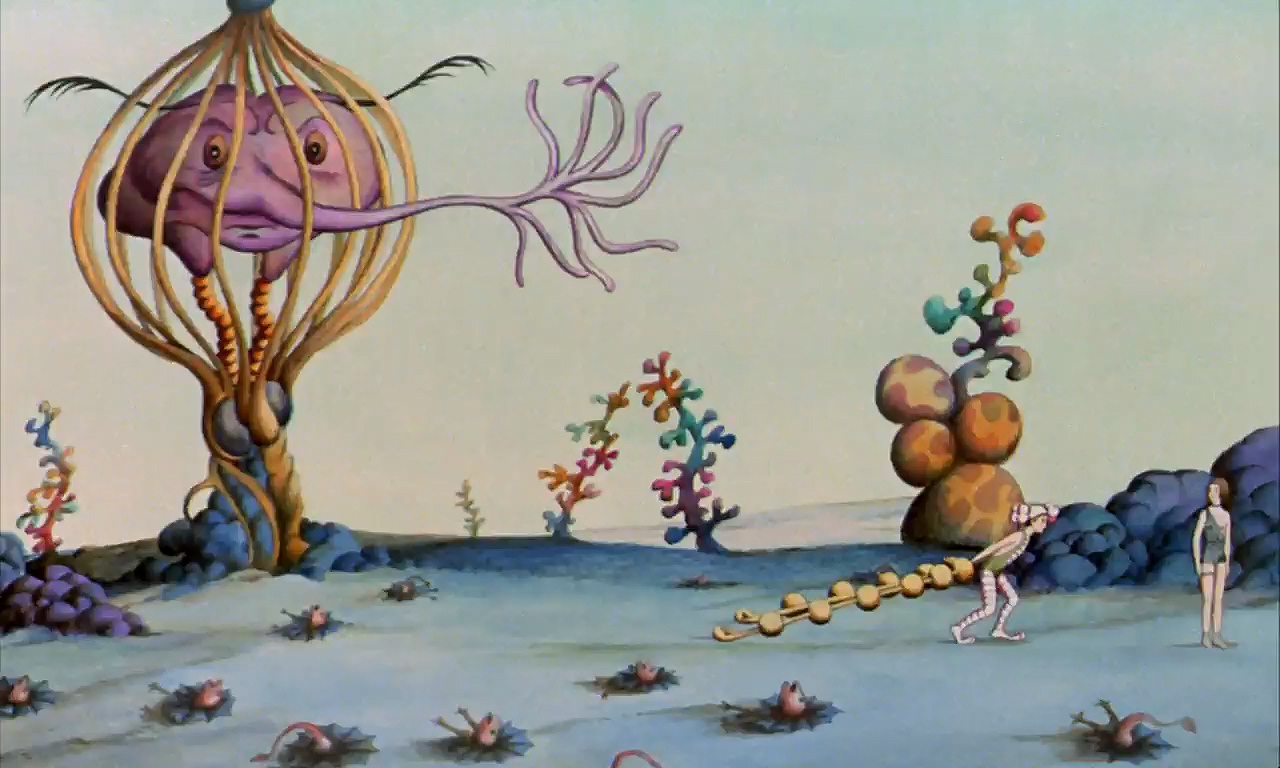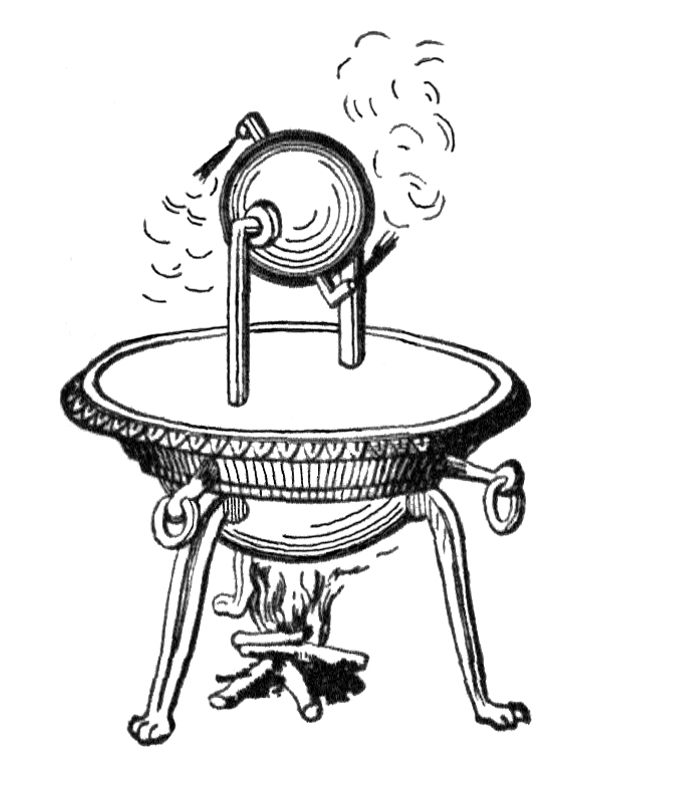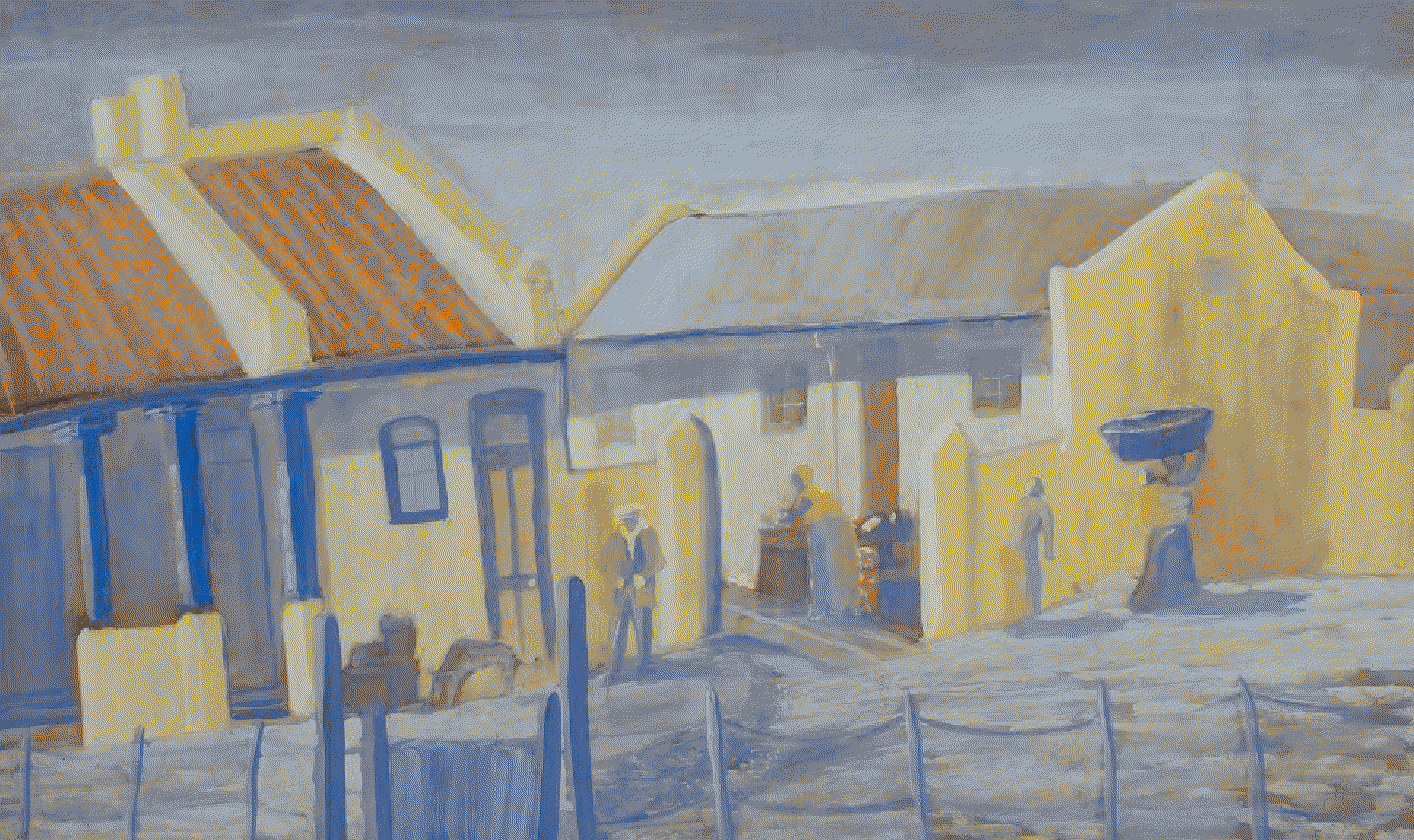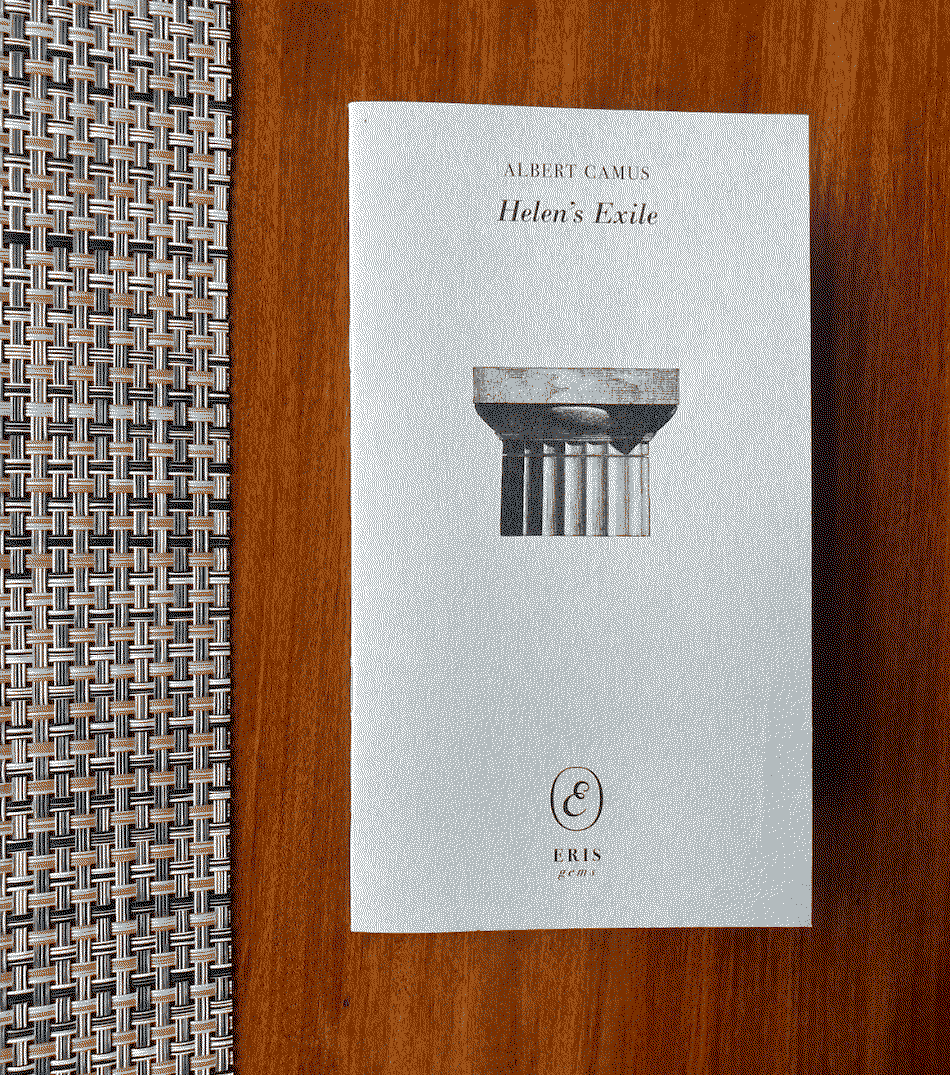Log (rss)
11.12.2025 // Ports of Refuge
Rabat, Morocco ⬔
Borrowed amidst criss-crossing tram lines, flat boulevards, narrow cobblestone streets, pitiless drivers of taxis, scooters, motorcycles and the all-too-daring pedestrians—there is a little café-shop that always brings me a sense of peace in Rabat. When I walk in, everything hushes, and then the sounds, smells, and sights gently pick up again.
Wandering recently between the shop's teas, spreads, shawls and postcards, a book caught my eye. Without much thought, I flipped open the thick hardcover and encountered humanoid birds, exuberant vines, patterns and patterns of palms, tiles, leaves. I was immediately enchanted by the drawings, watercolors, and paintings of Abbès Saladi.

There is something about Saladi's work that makes me think of the film La planète sauvage. I could actually imagine an exhibition of Saladi's drawings set to Alain Goraguer's excellent film score.

Coming back home, I discover that there is very little information available online about the artist (perhaps there is more out there in Darija). Much of his work is in private collections and auction houses. I decide that I will gather a few facts from the book in the shop and create a Wikipedia article. In fact, if I had a library of my own, I would have bought the book about Saladi's oeuvre right then and there.
These sort of encounters remind me why I set out to travel in the first place. And there have been so many so far. It feels as if only a moment ago I was admiring Gerard Sekoto's yellow houses in Cape Town and now I am admiring Saladi's sinuous bird people at the other end of the continent. These encounters have only multiplied as I have learned to set my shyness aside and seek them out. But perhaps what I need now more than anything is time to sit with all of these paintings, poems, bits and pieces of art.
- Andrea
27.11.2025 // An Anthology of Brazilian Literature
Rabat, Morocco ⬔
Between October and now, I have read a couple of really great books and I have been meaning to write about them. But I think I will give up on the monthly review structure. I should really just write about a book when I am excited to do so, otherwise it becomes a bit of a chore. There are also some books that take a while to digest, like Albert Camus' The Myth of Sisyphus, which in many ways I have been writing about for a long time now but always indirectly.
Something that is a bit easier to put on paper is a list of the wonderful stories that I encountered in an old anthology of Brazilian literature. I already dedicated one entry to a Machado de Assis story that really delighted me. I also mentioned Rubem Braga at some point. Now, here is the full list of the stories and authors that have stayed with me long after completing the whole book:
- "Um apólogo" de Machado de Assis
- "Festa" de Graciliano Ramos
- "História do Carnaval" de Jorge Amado
- "As mãos de meu filho" de Érico Veríssimo
- "Circo de coelhinhos" de Marques Rebêlo
- "Brinquedos incendiados" de Cecília Meireles
- "Gato, gato, gato" de Otto Lara Resende
- "Céu limpo" de Eduardo Campos
- "A aranha" de Orígenes Lessa
- "Uma vela para Dario" de Dalton Trevisan
And as a bonus...
Some other September + October Reads
- "Charulata: 'Calm Without, Fire Within'" by Philip Kemp
- "Patricia Lockwood Goes Viral" by Alexandra Schwartz
- "Highjump as Afrofuturism" by Gustav Parker Hibbett
- "Reading the Greeks Under a Blanket of Blue" by William Coleman
- "Fallen Fruit" by Don Mattera
- "When the Montuno Hits in Hong Kong: My Journey into Canton Mambo" by Gia Fu
- Andrea
13.11.2025 // Writing in Rabat
Rabat, Morocco ⬔
In Rabat, walls and rooms crumble into sea foam and towers rise on riverbanks. Cats always prowl just around the corner and in the shadowy depths of a worn and tattered grey building, I see a fire burning bright. Every morning, it spits out sweet cakes, hard breads, and cookies onto the sidewalk, to the delight of passer-by's. In Rabat, it rains plastic on the dirty blonde beaches and blue taxis race down perfectly palm-lined avenues. It has taken me a while to figure out how to write here. In the narrow, damp and dusty, streets of the medina, I am reminded of the smell of my great-grandmother's brick house in Bogotá. But once out among the merchants and the motorbikes, my ability to decipher what is before me recedes gently like the sea.
- Andrea
10.11.2025 // Aeolipile
Rabat, Morocco ⬔
I just came across the first recorded steam engine, the Aeolipile, also known as Heron's engine. It seems like it might not have been used for anything practical at the time.
It blows my mind to imagine that such a device existed so far back. In some sense, it represents to me "what could have been". Like, in an alternative past, what would the world look like had we explored this device's capacities further at the time? Yet, we did not, and it would take another 1500 years until the idea reappeared once more.
I wonder what inventions or ideas today may prove to be similar to the Aeolipile.

- Marc
25.10.2025 // A Protea is Not a Flower
Cape Town, South Africa ⬔
Last weekend, Marc and I visited the Zeitz Museum of Contemporary Art Africa (MOCAA) to view two new expositions that have opened up during the spring. The Zeitz is an impressive towering structure, a museum housed in an old industrial silo by the harbor. Every time I visit the museum, I am reminded of the special beauty that can be found within a repurposed space, and of all that there is to learn and experience within the museum's thick concrete walls.
This final visit was particularly meaningful, not just because our time in South Africa is drawing to a close, but also because I encountered the paintings of Gerard Sekoto and the poetry of Don Mattera for the very first time. Named after one of Mattera's poems, the exhibition "A Protea is Not a Flower" puts a spotlight on South African modernism and exile brought on by apartheid in the 20th century. In fact, Sekoto and Mattera are prominent names within South African art history, and I feel grateful that I will not leave Cape Town without experiencing their work.

Seeing paintings like "Yellow Houses in Sophiatown" and reading poems like "Fallen Fruit" elicited feelings not unlike those that I have felt when seeing the films of Satyajit Ray and Wong Kar Wai for the first time. Or when I stood on a beach of black sand for the first time. Like a first taste of pistachio gelato, a first reading of Jane Eyre. Awakenings that pull at the heart.
- Andrea
19.10.2025 // What is Art?
Cape Town, South Africa ⬔
Lately, I have been thinking that, while good art often uncovers what is hidden, allowing us to see lucidly across large spans of time and space, the short-form clips of our age seem to instead obscure our sight.
Take, for instance, the "tradwife" trend on TikTok and Instagram. There is perhaps no more powerful antidote to the digital mirage of seemingly young, healthy, and manicured women endlessly showing off pampered babies and sponsored cleaning products, than the short story collection I recently finished reading. In Banu Mushtaq's Heart Lamp, a young housewife cries out to her husband (and to us all): "Others are not even married at my age. But I am already an old woman [...] My back is broken. These children, the home, samsara—do I have even a minute of free time? If I bear one child per year, what will I become? Don't you want me to live long enough to be a mother to these children at least?"
- Andrea
01.10.2025 // Helen's Exile
Cape Town, South Africa ⬔
After an early start to the day and to the month of October, we sat down with one of the essays of Albert Camus, "Helen's Exile". It proved to be especially lovely, melancholic and thought-provoking on a grey rainy day like today, and Camus' literary flair is always awe inspiring. We picked out a few of our favourite quotes, some of which can make confronting current events feel less lonely, and some of which speak to some of the other reflections posted on Comma Directory recently.

"Our Europe [...] off in the pursuit of totality is the child of disproportion."
"In her madness she extends the eternal limits, and at that very moment dark Erinyes fall upon her and tear her to pieces. Nemesis, the goddess of measure and not of revenge, keeps watch. All those who overstep the limit are pitilessly punished by her."
"In a drunken sky we light up the suns we want. But nonetheless the boundaries exist, and we know it."
"In our wildest aberrations we dream of an equilibrium we have left behind, which we naively expect to find at the end of our errors."
"We, too, have conquered, moved boundaries, mastered heaven and earth. Our reason has driven all away. Alone at last, we end up by ruling over a desert."
"Whereas the Greeks gave to will the boundaries of reason, we have come to put the will's impulse in the very centre of reason, which has, as a result, become deadly."
"Nature is still there, however. She contrasts her calm skies and her reasons with the madness of men. Until the atom too catches fire and history ends in the triumph of reason and the agony of the species."
"But the Greeks never said that the limit could not be overstepped. They said it existed and that whoever dared to exceed it was mercilessly struck down. Nothing in present history can contradict them."
"The historical spirit and the artist both want to remake the world. But the artist, through an obligation of his nature, knows his limits, which the historical spirit fails to recognise. This is why the latter's aim is tyranny whereas the former's passion is freedom."
"[Our era] wants to transfigure the world before having exhausted it, to set it to rights before having understood it."
"Whatever it may say, our era is deserting this world."
"Yet what a temptation, at certain moments, to turn one's back on this bleak, fleshless world! But this time is ours, and we cannot live hating ourselves."
"Admission of ignorance, rejection of fanaticism, the limits of the world and of man, the beloved face, and finally beauty—this is where we shall be on the side of the Greeks."
- Andrea & Marc
24.09.2025 // Echoes
Cape Town, South Africa ⬔
One of the benefits of reading widely and constantly is that the opportunities for enlightening coincidences multiply. A line from Rubem Braga's "O Motorista 8-100" suddenly echoes with the writing of Camus. I listen to a lecture on Jane Austen's personal letters and think of Banu Mushtaq's short stories. I write about an encounter with a dying bird on the sidewalk, I read Caetano W. Galindo's Lia and encounter a scene in which the protagonist, Lia, encounters a dead bird on the sidewalk. Nothing is original, but everything is. This does not discourage me. Ideas repeat, but never exactly in the same way. It testifies to the common experiences that bind living beings together, and it also speaks to individualities that are irreplaceable.
- Andrea
10.09.2025 // Summer-Winter Reads: June, July, and August
Cape Town, South Africa ⬔
I have read and written less than I would have liked during the past three months. Not too unexpected, however, as it has been the part of the year in which I have traveled the most. After a month in Cape Town, I feel like I have some room for pause and reflection on the books that have accompanied me from Bath and London to the United States and now South Africa.

I realize now that my reading has been just as scattered as my physical presence: from a radio journalist's compilation of tales about the lives of Chinese women in the 80s and 90s to contemporary queer Latin American poetry and an academic analysis of the cultural impact of Ayn Rand. It has been interesting. So much so, that I do not really know where to begin.
Perhaps, I should begin at the beginning. And an important beginning for me is Jane Austen. Bidding adieu to Bath, I re-read Pride and Prejudice during my last few days in the UK. It happened spontaneously, or as spontaneous as it can be when at every corner I was reminded that it was the 250th anniversary of Austen's birth. Bath practically burst with Austen, and I eyed it all a bit skeptically. Maybe with a similar skepticism to that with which I approached Pride and Prejudice for the first time when I was in high school. However, Austen's eternally fresh and funny storytelling always manages to sweep away my reserve. With each re-reading, my appreciation only grows and I was pleased to have had the novel's company during the long hot nights of a London heatwave.
Some of my other reads this summer were less comforting, matching the anxious tone of the times, of degradation in all sense of the word. Mean Girl: Ayn Rand and the Culture of Greed by Lisa Duggan and The Good Women of China: Hidden Voices by Xinran are two non-fiction books that prompt reflection on how societies function and malfunction, and how this malfunctioning can profoundly hurt individuals, families, and communities. What ideas get to be influential and why? How do we displace harmful ideas and conventions?
The pessimism and anxiety that comes from ruminating on the world's biggest issues, some that perhaps seem unsurmountable, is one of the main themes of the other book that accompanied me on flights and train rides: A System So Magnificent It Is Blinding by Amanda Svensson. This big novel is full of quirky moving pieces, like a Murakami novel, but very Swedish and with less music. Faraway places, improbable images, coincidences that promise to be part of some big conspiracy. The three sibling protagonists try to make sense of a world that feels like it is going to pieces. In the end, I felt like this novel was an exercise in building suspense and anticipation only to purposefully disappoint in order to make a point. I appreciated the concept and the intent more than the novel itself, unfortunately. Not sure I would pick it up again, but I am glad to have read it.
In the midst of all of that, I stumbled into some poetry as well. Feeling a bit nostalgic for home, I picked up an anthology of queer Latin American poetry edited by the Argentine poet Leo Boix, as well as a newly published work by Boix. Within Hemisferio Cuir: An Anthology of Young Queer Latin American Poetry, I was pleased to discover poetry from across the region, including some countries that are less well represented on the global literary stage. These are the poems from the collection that stuck with me:
- "El agua de los sueños" de Flor Bárcenas Feria
- "Oda a Querelle de Brest" de Pablo Jofré
- "Una parra sube" de Paula Galíndez
- "Poetas enamoradas" de V. Andino Díaz
- "Cómo ser feliz siendo de Nicaragua" de Magaly Castillo
- "poema [post]umo" de Alejandra Rosa-Morales
- Andrea
26.08.2025 // Data Pods
Cape Town, South Africa ⬔
Traditionally, web applications have stored user data on their own servers, and thus, the server owners bear full responsibility for and ownership of that data. They can analyze it, sell it and manipulate it how they wish (which includes destroying it). Now, what if we flipped the script and instead of web applications storing user data on their servers, they needed user permission to read data users own? The user would then have full ownership of that data, and could inspect, remove and change ownership and access as they wish. Applications would also store the data on the users' servers instead of their own.
This is the idea behind the SOLID project, in which users would own what they call data pods. In other words, users would store semantic data in a pod and grant applications access to read from that pod. That way we can move away from companies like Meta storing and keeping so much information about us. SOLID is not the only company exploring this concept. AT Protocol, developed by Bluesky, does something very similar. Users can store their tweets on Bluesky's server, or host their own PDS, or personal data server, retaining ownership of their data on the pod.
ICloud arguably can also function as a data pod. It enables apps to store data directly to the user account instead of a server, enabling the seamless synchronization that comes with having data stored on a server.
Lately, I have also explored Caldav servers, which share some characteristics with a datapod. What I like about it though is that everyone is already signed up to some sort of email provider, and with that they most likely also have a calendar, which typically uses Caldav as the backend. Caldav uses the iCalendar media-type, and it is surprisingly flexible; it supports events, to-dos and even journals. There is therefore a lot of potential for interoperable social productivity tools and note-writing tools that hasn't really been explored.
- Marc